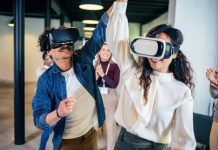
Picture an office space: cubicles, computers, off-white walls, and grey carpet. Perhaps there’s a motivational poster on the wall or some fun decor spritzed here and there, but overall, most corporate spaces do not evoke a feeling of fun, friendly, competitive spirit, or joyful play. These are spaces for work, seriousness, and keeping an eye on the bottom line.
However, this mindset has not served the corporate training industry well. Corporate training has a reputation for being boring and, well, very corporate. It’s the nature of the beast.
Yet, with more Gen Z workers entering the space, there has been a recent movement to make corporate training and hiring systems more engaging and fun. The goal is to encourage employees to stop rushing through dull training modules and adopt an onboarding and training approach that incorporates elements from modern gaming culture or utilizes existing games to teach employees everything they need to know, ensuring the lessons stick.
Fun and focus
Traditional methods of training, upskilling, and onboarding have struggled to fully capture the attention of employees raised within the gaming culture, which is heavily rooted in competition and community. Gaming also employs psychological triggers that keep people glued to consoles, and these triggers can similarly keep people engaged with training modules that incorporate modern gaming elements.
Modern corporate trainers and HR professionals are becoming increasingly aware of the distinct differences between Gen Z and Millennial workers, as well as their different approaches to learning and working. These leaders aim to bring fresh energy to the workforce and are eschewing traditional tactics, instead adopting gamification, ranging from small-scale branded competitions to full-scale esports tournaments. Elements such as leaderboards, badges, team-based challenges, and virtual reality are being adapted for the corporate setting to create more engaging and memorable training experiences.
According to recent studies, gamification of corporate training can result in a 48 percent increase in employee engagement. In the same studies, 83 percent of employees reported feeling more motivated at work through gamified training.
Clearly, gamification can be successful. So, how do corporate leaders best apply elements of gaming culture to their training?
Easier than you think
Today’s younger workers are seeking training that extends beyond simple gamification, with its sometimes meaningless badges and forgettable leaderboards. Instead, many corporate leaders are taking gamification to the next level by leveraging existing video games to their advantage.
Currently, games such as “Among Us” and “Fall Guys” are where the action is with Gen Z and Millennials. These games feature built-in mechanics that foster excitement and competition. Rather than struggling to create their own badges and point system, corporate training leaders can leverage the leaderboards, rewards, and team dynamics from these existing games that already have people hooked.
Going big can also benefit corporate training. Some companies have turned training into a full-blown esports tournament to kick training into high gear, allowing employees to form teams, create their team logos, and battle it out in a structured event that feels far more like a gaming competition, to which many Gen Z workers are accustomed, than a corporate training exercise. The results are a stronger sense of community among workers, increased engagement, and a team that genuinely enjoys coming to work.
Training leaders need not overthink gamification. They can utilize games their team already knows and loves, embracing those familiar mechanics to create a training experience that is genuinely fun, rather than mind-numbingly dull.
Taking the mystery out of gamifying training
Gamification is not a mystery waiting to be unlocked; it is simply about connecting with people using methods they are already familiar with. As the old guard begins to pass the baton to younger generations in the workplace, gamification may become an increasingly ingrained part of corporate culture.
Leaders can examine organization-wide metrics to determine whether gamification of training is suitable for their organization. After all, there can be many ancillary benefits to gamifying training. Those who participate fully in gamified training may be more willing to share their knowledge with others or encourage their work peers to become more engaged in training. Organizations that establish clear, measurable goals from the outset will likely benefit from their pre-planning and forward-thinking approach.
The working world is evolving. Where once gaming culture was dismissed as child’s play, corporate leaders from all generations are taking notice of the benefits of gamification in terms of engagement, learning outcomes, and retention. By borrowing elements of gaming culture and esports and applying them to corporate training, organizations successfully bridge generational gaps and appeal to the digital natives entering the workforce in droves.
Gamification of corporate training is not just another passing trend. It represents a shift in the way corporations are creating a more skilled and plugged-in workforce. As we move forward and Gen Z takes its place as leaders in all industries, gamified training will likely become a crucial strategy for staying competitive in nearly all markets.




